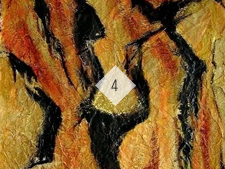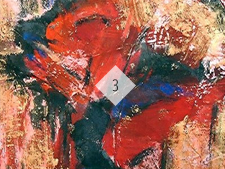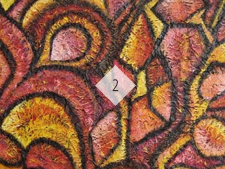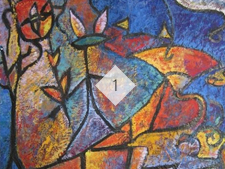W
Cécile Girard: A Poetic Fusion of East and West on Xuan Paper
Cécile Girard, a courageous and visionary French artist, pursues a profound fusion of Eastern and Western art in her work. As Ma Lin, professor at the Shanghai Academy of Fine Arts and art critic, observes, she skillfully combines the rough texture of stone with pictograms, transporting the viewer into an ancient space-time. This juxtaposition reflects the depth of primitivism, an enduring theme in art history, particularly significant after the revolutions of Impressionism and Cubism. Inspired by Eastern spirituality, Cécile Girard uses the porosity of Xuan paper to infuse her work with a unique introspective depth, highlighting the distinct allure of Eastern art.
As Professor Li Ping of Shanghai Normal University points out, the influence of Chinese landscape painting is notable in her work. Although Girard adopts an abstract style, her work incorporates essential elements of traditional landscape painting, particularly in her nuanced control of ink layers and depth. By skillfully managing the ink’s tonal variations, her works resonate with Chinese aesthetics, achieving a rhythm and melodic quality. Her compositions are free yet maintain the harmony and dynamic balance of traditional landscapes, imbuing her contemporary work with a deep reverence for tradition.
Gu Jiajun, Deputy Director of the Duolun Museum of Modern Art in Shanghai, highlights Girard’s bold experimentation with Xuan paper, a central material in her work. Through innovative techniques of folding, collage, and layering, she creates a unique three-dimensional texture on this traditional surface. Gu notes that her approach recalls the “three distances” method used in Song Dynasty landscape painting, creating an immersive visual experience, reinterpreted here by a Western artist.
Since arriving in China in the 1990s, Cécile Girard has deepened her understanding of Chinese art, incorporating landscape painting techniques and symbols into her work. Using the graphic language of calligraphy and the structure of landscapes, she imparts a mystical depth to her creations.
As Gao Chunfang, an expert in traditional Chinese painting in France, notes, she naturally combines Eastern and Western techniques to forge a unique style, where Western expressiveness meets the subtlety of the Eastern brushstroke. In her recent series, Girard pushes beyond visual representation, using ink and Xuan paper to create compositions that evoke a Zen spiritual dimension, characteristic of Chinese scholar painting.
Thus, Cécile Girard’s work goes beyond abstract painting, becoming an exploration of the transformative potential of traditional Chinese painting in contemporary art. Her compositions, rich in color and dynamism, reflect her bold integration of Chinese painting, achieving a mysterious balance between abstraction and figuration, East and West. As Li Ping states, she combines traditional techniques with a modern vision, expressing a deeply symbolic and profound personal cosmology.
In sum, Cécile Girard’s art respects Eastern spirituality while innovating in materials, paving new paths for intercultural dialogue in art. Her work invites us to rediscover painting as a universal language, where each brushstroke and texture conveys a broader perspective of the world, showcasing the depth of Eastern art and the vitality of modern art.




